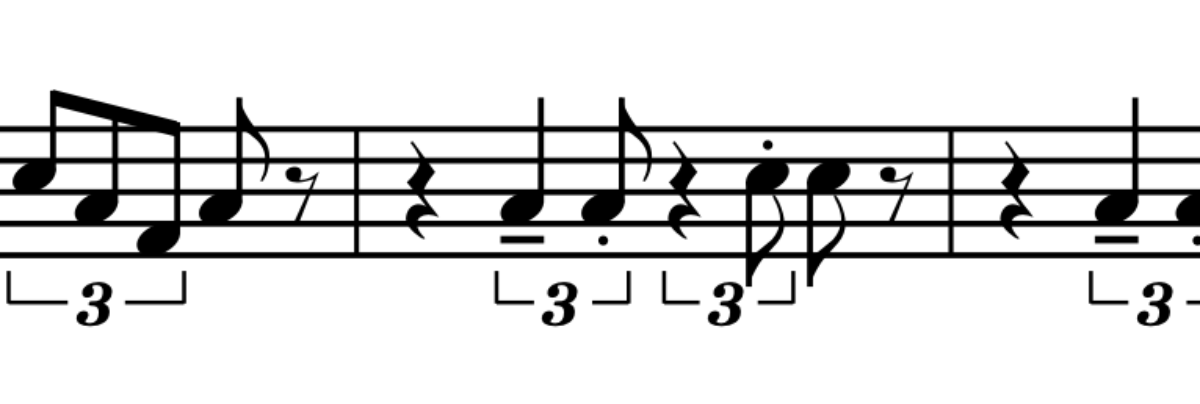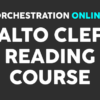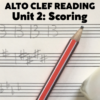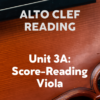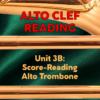(Tip no. 57 from 100 MORE Orchestration Tips, to be released March 2020)
Percussion instruments of similar timbre and attack can be quite different from one another in performance. The orchestrator should factor in range, intensity, and colour in choosing the correct instrument for a specific role.
It sometimes takes a while before composers get the exact knack for picking the right percussion instrument for the right task. Even in the case of standard repertoire, there are sometimes classic substitutions supplied by percussionists for when a great composer’s judgement got the better of them. Here are a few pointers to help you narrow down your choices with more confidence.
The baseline for a choice of percussion instrument is usually a very general desire for a kind of timbre and attack – like clanging bells, or a punchy, pitched drum. When I score, I use more specific parameters such as those I’d apply to any wind, brass, string, or keyboard instrument. What kind of range do I need, pitched or unpitched? What kind of intensity am I bringing to a passage? What exact colour does each instrument have, and how will that work best in the specific texture?

High-pitched bell-like instruments. Here is where I see some developing orchestrators immediately go wrong, as the choices are so plentiful. Between triangle, glockenspiel, celesta, antique cymbals, and vibes, which is the right instrument? Here are a few guidelines. If the pitch needs to be ambiguous, then triangle is the right choice, especially in softer passages. None of these instruments are all that loud, but if there’s a need to be heard in stronger passages, then glockenspiel will probably have the best carrying power; while celesta may simply disappear in the onslaught (see 100MOT 70). Lower pitches are better on vibraphone than any of the others; a glockenspiel’s disappointing thunk equals a singing ting on vibes on the same sounding pitches (say concert G5-C6). It’s hard to beat the sustain of the vibraphone as well, especially with the motor on, and its variety of expression can be astonishing. But the natural tunefulness of glockenspiel is hard to beat, though its eternal optimism may be wearing at times. Perhaps in those instances, antique cymbals are the cure, though they’re not universally available in orchestras great and small. But if complexity is required and the dynamic is soft, then celesta is the best option. Very loud but complex, and you should be asking the orchestra manager if there’s a keyboard glockenspiel (jeu de timbres) available.

Fig. 57b: Goss, Battle of the Mountains, timpani part, bars 3-8. This piece calls for the full set of five timpani, including the 21-inch piccolo with a range up to the written B3 in the last two bars.
High timpani vs. roto-toms. Here I feel there’s absolutely no question about the superiority of the high 21-inch timpani vs. a similarly-ranged set of rototoms. The 21-inch timpani can cover pitches from F3 to B3 or even C4, and is just as easily tunable as all the other timpani. Rototoms actually cover most of the same range as timpani, with the 18-inch tom sounding as low as E2; but in this instance, I’m comparing the use of the 16-inch to 8-inch toms over the same range as the 21-inch timpani. Since Adler first raved about them in The Study of Orchestration back in the 1980’s, I’ve been seeing their use crop up from time to time, usually for extending the range of the timpani upward. My take on this is that for notes from Middle C upward, rototoms can be quite effective, and the technique and general rich attack is essentially the same, with an even clearer sense of pitch to a degree. But with that last advantage comes a certain shallower quality. Some purists might even call it “cheesy” – though I’ve heard rototoms being used in more profound ways. Part of the problem lies in telescoping the qualities of timpani ever higher and higher, until what was once profound becomes a bit of a parody of itself. This is very clear when it’s a choice between the 21-inch and a set of rototoms in the same range. Also there’s the issue that rototoms have no options for quickly changing their pitch like timpani. So they’re pretty much set for the programme (I would not ask the timpanist to retune rototoms mid-concert). If I had the need and could count on the availability of rototoms in a score, I would probably keep their tuning below G4, and avoid gestures that sounded too much like clichéd rock drum fills from the 1980’s.

Low timpani vs. bass drum. There’s a tendency in epic music, especially film music, to push timpani lower and lower for an incredibly dramatic sound. However, the lower a drum is adjusted, the looser the head, until finally the flabbiness may appear meaningless to a timpanist. You may be better off in very low, profound scoring to just choose a bass drum, which can actually be tuned up a bit to a tighter pitch (while still appearing unpitched), coming in under the lowest satisfactory notes of the timpani. Future film composers may well be wondering how the taiko drum applies here, and I’d respond by say that is yet another unique sound, which may have outlived its welcome in soundtracks. A similar effect can be somewhat achieved through the unison of low timpani and bass drum, as scored by Stravinsky near the end of The Rite of Spring.
Drums without snares. Questions sometimes arise over the appropriate drum to use: tenor drum, tom-tom, snare drum with snares out, or even a field drum. Some of this is just due to unfamiliarity with the different kinds of drum. Think of a field drum as similar to a tenor drum with snares, and we can eliminate it. From there, the questions once again return range, intensity, and colour. Snare drums have a very bright sound and sharp attack, due to small body and high tension, and without the snares engaged can contribute a uniquely insistent quality to a rhythm. The tenor drum has a similar attack, but a more profound tone. It’s excellent when the tone needs more fullness and body. Tom-toms on the other hand have more spring, and perhaps more identifiable tuning. This is one small step toward the pitchiness of rototoms, but nowhere near as much unless the heads are quite tight.
I’ve used tenor drum frequently, as well as tom-toms, and I feel that they’re quite distinct instruments. The feel of a tenor drum is more direct, even more urgent. They’re excellent for quickly and indelibly getting the point across. Tom-toms are more casually energetic, good for grooves and longer lasting time-keeping.

Fig. 57d: Goss, Tane & the Kiwi, tom-tom part, bars 613-618.
All kinds of cymbals. Coming to concert music from popular music, a composer might well be aware of commonly used cymbals used in drum kits, but not be aware how that translates to orchestral percussion. Likewise, a concert composer raised on the classics might not be aware of drum kit options. The first thing to consider is the similarity between orchestral cymbals and the ride cymbal. They have a comparable weight and timbre, and the sound is not too different. But it’s different enough to request the specific type of cymbal rather than substituting one for another (unless the percussionist tells you not to worry about it). Orchestral cymbals have a certain carrying brightness that cuts through a bit better than a ride cymbal’s laid-back tishing. Both have a nice big sound. The attack from a cymbal pair has a brighter, more metallic sound than that of an orchestral suspended cymbal, without being as pushy as a drum kit’s crash cymbal. The hi-hat cymbal is another kind of sound entirely: shallower, capable of a sizzling sound when the hats are loosely engaged, or a kind of metallic ticking when resting together. Then there are other cymbals specific to kit drumming like the so-called “China” cymbal, in which the plane of the cymbal is partially reversed for a more tam-tam-like sound. All I’d observe is that kit drum cymbals are probably not too hard for a percussion section to supply, but they may bring a certain rock context to the music. And just as with rock, those cymbals tend to take over certain bandwidths within the music, making other instruments less easy to hear.
If a China cymbal sounds like a tam-tam, then could it substitute for one? I’d disagree, because tam-tam has a much deeper, longer-sustained sound. There’s a tendency for tam-tam to be misnamed “gong” in some scores (notably Holst’s Planets), but that’s a different different instrument entirely. Gongs have very complex set pitches, with audible overtones; while tam-tams intentionally built to avoid a definite pitch (though there is a kind of brutal, singing overtone in all tam-tams).
Xylophone vs. Marimba. I touch on some of these issues in the previous tip, and also provide a comparison of their waveforms in 100MOT 69. But keeping to the same set of parameters in this tip, we can judge the xylophone to be brighter and and more intense than the marimba, but with less colour and sustain. The marimba’s darker tone is also matched by lower available pitches across the bass staff; while the xylophone’s lower notes are more thunky and less satisfying. Marimbas also have a quite generous and usable treble range, but it’s subtler in articulation and softer in projection. It would completely disappear in unison with ff trumpets, while the xylophone would have no problem punctuating their every note with audible conviction. But with the xylophone’s superior intensity and volume comes a kind of inescapable abruptness and separation of tones. Marimba has a built-in sense of fluidity and legato, easily connecting melodic gestures and figuration.

Even if the composer finds all the most ideal instruments for the specific passages in question, they still might have to deal with concerns of section size and economising, particularly when scoring a work that will be toured by a smaller group of players. A schools tour that I developed with Orchestra Wellington gave me the option of all the percussion instruments I could ever want; but as the years went by, it became more and more essential to cut down on involved packing in and out, plus hiring a truck and a driver. Working with the players, I reduced the size of the ensemble so their entire rig could fit into a small van. This won’t be a concern for a work premiered in a concert hall or in a film recording studio, but even at that you may want to confirm the availability of rarer instruments like antique cymbals or keyboard glockenspiel.
You’ll also need to use your ear to make some of these determinations for yourself. Score-read works with generous percussion parts, and listen for how the instruments fit into the overall soundscape. As for the precise sound of each individual instrument, there are many demos that have been posted to YouTube, sometimes even as audition examples from players trying out for orchestra jobs. All of these can help you add clear impressions to your inner toolkit, and help lead you to the choice of instruments that don’t just work in a passage, but make the passage work.

